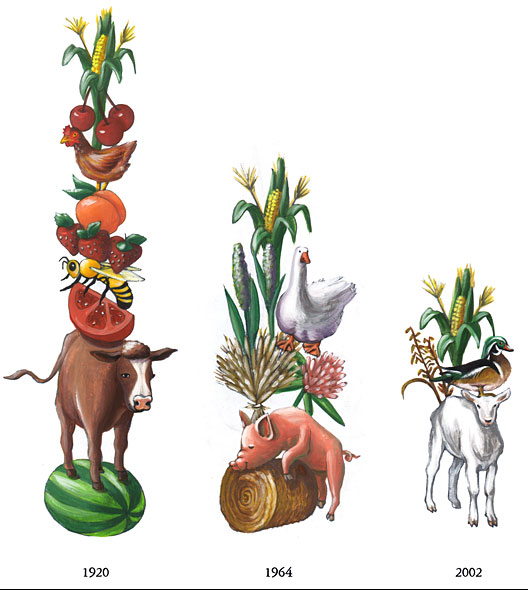During my trip to the Midwest this summer, I saw many unsettling sights: vast monocropped landscapes lashed regularly with chemicals, insidious low-slung buildings that imprison thousands of animals and concentrate their waste.
Yet I returned oddly invigorated, buzzing about Iowa’s promise as a sustainable-ag mecca. Amid the cornfields and the CAFOs, I saw thriving homestead farms where people are raising organic vegetables alongside pastured, happy hogs. I saw bustling farmers’ markets and met chefs whose buy-local fixations might make them the toast of Berkeley or Santa Cruz.
I came back with a mantra: Iowa today is California circa 1972. One friend shot back a stern response: “minus the thousand miles of oceanfront.”
Oh, right: the beach and all of that. Next I’ll hear nitpicking about how Iowa doesn’t have California’s eternal-spring weather. Still, consider the similarities. Both states have rich soil and near-ideal growing conditions for a variety of crops — a wide variety of fruits and vegetables, including tomatoes, watermelons, and other delights, flourished in Iowa [PDF] just a couple of generations ago. Corn and soy have Iowa’s land in virtual lockdown now, but that’s a recent phenomenon. The state’s transformation from cornucopia to corn-topia was driven by decisions made in corporate offices and Washington back rooms, not by farmers responding to conditions in the field.

Iowa’s crop diversity has dwindled since the early 20th century, but times may be a-changin’.
Illustration: Keri Rosebraugh
Source: Leopold Center for Sustainable Agriculture
And in the early 1970s, industrial interests had just as much a grip over California’s farms as they do Iowa’s today. In her book Agrarian Dreams: The Paradox of Organic Farming in California, Julie Guthman shatters the myth that the family-scale farming currently supplying restaurants like Chez Panisse and other sustainable-food landmarks has deep roots in California history. “California never had much of an agrarian smallholder tradition,” she writes. “Large landholdings became the basis of farming from shortly after the gold rush, when an elite few brought much of its hinterland under monopolistic control.” Her conclusion: “California agriculture was industrial from the get-go, characterized by … ‘factories in the field.'”
Thus California’s much-celebrated cadres of small-scale organic farmers are charting new ground, not building on old traditions.
In Iowa, too, images of a Jeffersonian smallholder tradition are more rooted in nostalgia than historical fact. According to popular mythology, the Iowa we know today was essentially created by the 19th-century Homestead Act, which offered new farmers 160 acres of prime prairie in exchange for settling there. In his excellent 1996 book Broken Heartland: The Rise of America’s Rural Ghetto, Osha Gray Davis tells a different story. According to Davis, the Homestead Act quickly became embroiled in corruption; the best land tended to go to speculators and the railroad companies. “Just one out of every six acres distributed under the Homestead Act went directly from the government to settlers as intended,” Davis writes. “By 1935, half of Iowa’s farmers, the quintessential yeomen of [Thomas] Jefferson’s dream, were tenants.”
But if California managed to shake off a similar history and launch a local-food revolution, then Iowa and the rest of the corn belt can, too.
Some say a local-food economy could never work in places like Iowa — population density is too low. That, too, may be a myth. The agriculture economist Ken Meter has shown again and again that even in thinly populated rural areas, switching a significant amount of land from commodity production destined for distant markets to local-food production makes economic sense. In one eight-county region [PDF] of northwest Iowa with just 266,000 residents, consumers spend $400 million on food products from outside the region. Meanwhile, farmers typically lose about $62 million every year growing commodity crops for industrial buyers like Archer Daniels Midland. By shifting 20 percent of their food expenditures to products grown within the region, consumers could significantly boost the farm economy.
There’s a strong ecological case for diversifying and localizing production as well. Just this week, the National Academy of Sciences released a blunt report showing that agricultural runoff in the upper Midwest, an area dominated by corn production, is degrading waterways from farm streams to the Mississippi, clear down to the Gulf of Mexico.

Until tomorrow.
Photo: Mark Hirsch
And as Elizabeth Royte showed in her article for this series, the federal government doesn’t even regulate some of the worst water problems caused by industrial agriculture: for example, CAFOs rely on antibiotics to keep their animals alive, and traces end up in manure and then in streams. “Antibiotics don’t break down in treatment plants, and since the federal government sets no limits on these contaminants, water plant operators aren’t required to test for them,” Royte writes.
That’s disgusting — and unnecessary. There’s no good reason to spoil streams and rip apart our social fabric just so a few companies and individuals can make a killing by confining animals.
In this series, we’ve highlighted brave citizens battling the CAFO-ization of their communities, and others who are organizing to rebuild the local-food infrastructure that has withered away as a few large companies consolidated their grip on the means of food production. I think we’ve identified a revolution in the making. And as Pat Garrity, general manager of the Floyd Boulevard Local Food Market, told me, “If we can make local food work in Sioux City, Iowa, it can happen anywhere.”



